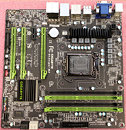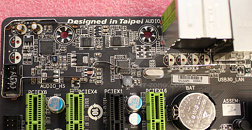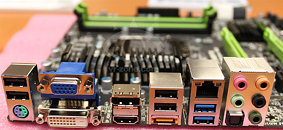Friday, March 2nd 2012

Gigabyte's First Micro-ATX G1.Killer Motherboard Pictured
A little earlier, we were treated to pictures and details of the Gigabyte G1.Sniper 3 motherboard based on Intel Z77 chipset, supporting LGA1155 "Ivy Bridge" and "Sandy Bridge" processors. Presenting, Gigabyte's first G1.Killer series motherboard in the micro-ATX form-factor, the G1.Sniper M3. This new board is based on the same Z77 chipset, and is backed by a fairly exhaustive feature-set that makes it a formidable high-end micro-ATX gaming desktop choice (good for LAN party rigs). The LGA1155 socket is powered by a 9-phase VRM, which draws power from a 4-pin ATX connector (instead of 8-pin EPS). The socket is wired to four DDR3 DIMM slots, supporting dual-channel memory.Out of the four expansion slots this form-factor permits, three slots on this board are physical PCI-Express x16. The topmost one is PCI-Express 3.0 x16 (x16/x8), the bottom-most one is electrical PCI-Express 3.0 x8. These two slots are wired to the CPU. The x16 slot in the middle of the two is electrical PCI-Express 2.0 x4, wired to the Z77 PCH. Then there's a PCI-Express 2.0 x1, also wired to the PCH. SATA connectivity doesn't rely on any third-party controllers, internally there are two SATA 6 Gb/s ports, three SATA 3 Gb/s, the fourth 3 Gb/s port is wired out as eSATA, on the rear panel.Further, the board doesn't rely on third-party USB 3.0 controllers. There are just four USB 3.0 ports, two on the rear-panel, two via front-panel header, all four wired to the PCH. Like the G1.Sniper 3, this board lacks fancy Creative or Bigfoot made connectivity. It makes use of Creative Sound Core3D audio, which is backed by amplifier circuitry that's better ground-isolated from the rest of the motherboard; and Intel 82579V gigabit Ethernet. Display connectivity includes one each of DVI, D-Sub, HDMI, and DisplayPort. A number of USB 2.0 ports top it off.
Source:
VR-Zone



31 Comments on Gigabyte's First Micro-ATX G1.Killer Motherboard Pictured
Also, BTA, I do see a Creative CKA02? chip there.
Move along, move along; nothing to see here.
Although, of course, the "G.1-Series" isn't Gigabyte's OC product, anyway.
To be honest I don't see anything particularily wrong with the board. Kinda miss the KillerNIC though. The only thing that stands out is the 4-pin CPU power connector, but agian, 1155 IB chips wil literally sip the power, with a 77W TDP... and 144W should be enough to OC thse chips, so only a single 4-pin is really needed, anyway.
The Gigabyte does of course have the advantage of being Z77, whereas the Maximus IV Gene is Z68. Not sure how much that matters, yet.
I'm just overly eager to play with another UEFI Gigabyte board! The X79 boards are pretty damn good!
SB chips are 95W stock, don't need 190W, so that seemed like a safe number. Very few current Intel chips can even exceed double the TDP, unless under extreme cold.
I feel like an arse for posting this, as it doesn't change anything, but, er...
77x2 isn't 144 :(
Sli/x-fire is ruled out, only 4 sata ports, no led debug, no power/reset switch and that vrm, they've just stuck a core3d chip on the z77 ud3 and cut it in half :shadedshu
asrock or asus then as i doubt msi will bring a high end matx board to the party
Define "super-performance". In fairness though, in light of Cadaveca's comments, you're probably right. The proof will be in the pudding.
By the looks of it, the change in the inductors, could hint towards more current capability per phase.
phase count is only important when all manufacturers use the same quality per phase, which has never been true.
Even though I didn't care for magazine clips and cheesy fake handguns as SB coolers...I do like the recent color themes from Gigabyte...with DFI out of the picture I've noticed Gigabyte delving into their color schemes?
Best,
LC